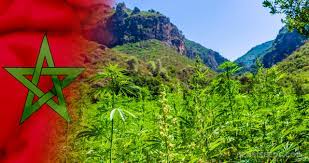With the legalisation of cannabis for medical, pharmaceutical and industrial purposes in 2021, Morocco’s ambition is making a major splash in the European market.
This year, the country exported legally grown cannabis to Switzerland for the first time. However, there are still many challenges to overcome, including strict regulations, high costs, the climate and increased competition.
Already one of the world’s largest producers of illicit cannabis, with 23,000 tonnes of cannabis and 800 tonnes of resin by 2021 according to the UN, Morocco is seeking to transform this illegal production into a legal industry.
The aim of legalising is to offer better prices and conditions to producers. Authorised cultivation areas have increased to 3,000 hectares, mainly in the provinces of Al-Hoceima, Chefchaouen and Taounate, with nearly 3,300 recognised growers.
However, the first harvest of legal cannabis in 2023 was marked by climatic challenges, with the country producing just 296 tonnes, with a 20 percent loss due to extreme heat waves. Unlike European production, which takes place mainly under glass, outdoor cultivation in Morocco is vulnerable to climate change.
What’s more, importing seeds from Europe increases costs. The National Agency for the Regulation of Cannabis-related Activities (ANRAC) is advocating the use of the local ‘beldiya’ variety, which requires less water and should be available by 2025.
Despite these challenges, investors see huge opportunities in the legal cannabis sector, estimated by a US investment fund to be worth more than $50 billion by 2028. Some 200 operators, including French companies, are already working with Moroccan cooperatives.
The Bio Cannat cooperative has registered ten THC-free CBD-based products, mainly food supplements and cosmetics. The pharmaceutical laboratory Sothema has developed some fifteen cannabis-based medicines
with a high THC content, designed to treat painful conditions such as cancer, multiple sclerosis and epilepsy.
These products could be launched on the market by 2025, both in Morocco and in several European countries.
Morocco is aiming for a 10-15 percent share of the European market, capitalising on the wave of legalisation of medical cannabis in the European Union, where 21 member states have already authorised the practice. The Moroccan Federation of the Pharmaceutical Industry and Innovation (FMIIP) hopes to generate between €400 and €600 million in annual revenues within four years.
ANRAC also identifies a number of potential sectors for the use of Moroccan cannabis, including aviation, food, construction, hygiene, paper, plastics, textiles and even CBD treatments for pets.
MN/te/fss/as/APA


